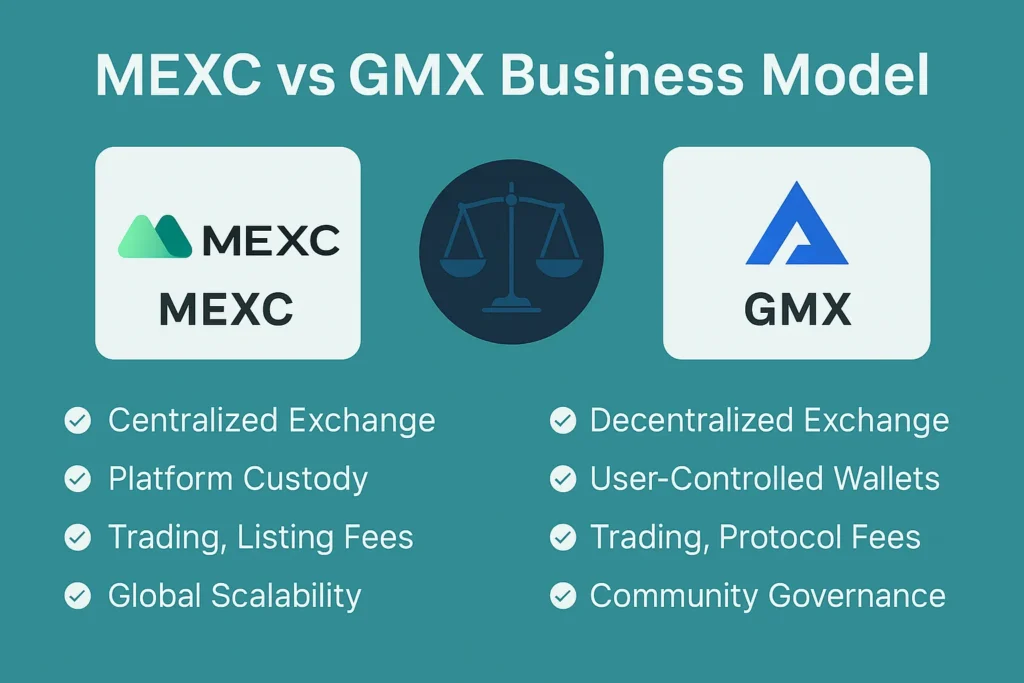In 2025, the decentralized finance (DeFi) and centralized exchange (CEX) ecosystems are at the forefront of the digital economy. The global crypto user base has surpassed 500 million, and both trading volumes and user expectations have skyrocketed. In this competitive landscape, two names stand out for aspiring crypto entrepreneurs: MEXC and GMX.
While MEXC represents the flexibility and global scale of a centralized exchange, GMX symbolizes the promise of decentralized, community-governed trading. Understanding their business models is crucial for startup founders and app entrepreneurs deciding which crypto exchange model to emulate.
This comparison goes beyond features—we’ll uncover how MEXC and GMX generate revenue, manage costs, scale growth, and structure partnerships. Whether you’re building a MEXC-style exchange or planning a GMX-inspired DEX, this blog will guide your strategic direction for success in 2025.

What is MEXC?
MEXC (formerly known as MXC Exchange) is a centralized cryptocurrency exchange (CEX) founded in 2018. Headquartered in Seychelles, MEXC offers spot trading, futures, staking, launchpad investments, and margin trading—targeting both beginners and seasoned traders.
Key Highlights:
- Over 1,600 listed cryptocurrencies
- Strong presence in Asia, Europe, and Latin America
- Offers copy trading, launchpad, ETF margin products, and more
- Known for fast listing of trending tokens and high liquidity
What is GMX?
GMX is a decentralized perpetual exchange launched in 2021. It enables perpetual futures and spot trading directly from crypto wallets. GMX is built on Arbitrum and Avalanche—two high-speed Layer 2 blockchains.
Key Highlights:
- Non-custodial: Traders retain wallet control
- Supports zero slippage trades via aggregated price feeds
- Powered by its native token GMX, with fee-sharing incentives
- Uses GLP (liquidity provider token) to bootstrap liquidity
Business Model of MEXC
MEXC follows a Centralized Exchange (CEX) business model, meaning the platform has custody over users’ assets and manages all trade matching internally.
Revenue Streams:
- Trading Fees (spot & futures)
- Listing Fees from crypto projects
- Withdrawal & margin fees
- Staking commissions
- Launchpad allocations and partnerships
- Copy trading profits
Cost Structure:
- Infrastructure costs (servers, security, trading engine)
- Compliance & licensing
- Marketing & influencer partnerships
- Customer support & legal teams
- Token development and ecosystem support (MX token)
Key Partners:
- Liquidity providers
- Token projects launching via MEXC
- Payment gateways
- Security audit firms
Growth Strategy:
- Expansion into new, emerging markets
- Fast token listings to ride hype cycles
- Community building via staking & rewards
- Launchpad and token fund integration
Learn More: Business Model of MEXC : Crypto Platform Earns Revenue
Business Model of GMX
GMX operates on a Decentralized Autonomous Exchange Model—revenue is shared with the community, and all operations are transparent and automated via smart contracts.
Revenue Streams:
- Trading Fees (leveraged trading, swaps)
- Liquidation Fees
- GLP staking rewards
- Protocol-owned liquidity earnings
- Governance token appreciation (GMX)
Cost Structure:
- Smart contract development & audits
- Chain gas fees (Arbitrum & Avalanche)
- Community incentives & liquidity mining
- DAO operations & grants
- Security maintenance (bug bounties, insurance)
Key Partners:
- Chainlink (oracle feeds)
- Arbitrum & Avalanche ecosystems
- DeFi aggregators like 1inch, DeBank
- Wallets (MetaMask, Trust Wallet, etc.)
Growth Strategy:
- Community-led feature rollouts via DAO votes
- Expansion to other L2s & multichain trading
- Incentivizing GLP holders and traders
- Attracting DeFi-native users with privacy & control
Learn More: Business Model of GMX : Revenue Streams and Strategy
Comparison Table: MEXC vs GMX
| Feature | MEXC | GMX |
|---|---|---|
| Type | Centralized Exchange (CEX) | Decentralized Exchange (DEX) |
| Founded | 2018 | 2021 |
| Custody | Platform-controlled wallets | User-controlled wallets |
| Revenue Model | Trading, listing, staking, copy-trading | Trading, protocol fees, liquidity rewards |
| Governance | Centralized | Community DAO |
| Liquidity | Internal order book | GLP-based pool |
| Tokens | MX Token | GMX, GLP Tokens |
| Tech Stack | Proprietary + Web2 hybrid | Smart contracts on Arbitrum, Avalanche |
| Scalability | Global CEX scale | Limited to blockchain throughput |
| Compliance | Subject to KYC/AML | Pseudonymous, no KYC |
Pros & Cons of MEXC Model
Pros:
- Fast listing = high user activity
- Multiple revenue streams
- Controlled, scalable infrastructure
- Easy onboarding for new users
Cons:
- Custodial = user risk
- Regulatory exposure
- Centralized trust model
Pros & Cons of GMX Model
Pros:
- Decentralized and transparent
- Community-owned rewards
- No KYC required
- Ideal for DeFi-native users
Cons:
- Limited scalability
- Complex for non-crypto natives
- Dependent on liquidity pool health
Market Data: Growth, Revenue & Funding (2025)
| Metric | MEXC | GMX |
|---|---|---|
| Monthly Volume | ~$15B+ | ~$2.2B |
| Active Users | 6M+ | 700K+ |
| Revenue (2024 est.) | $200M+ | $25M+ |
| Token Market Cap | ~$450M (MX) | ~$350M (GMX) |
| Funding Status | Privately held | Community funded, DAO-led |
| Main Geography | Asia, LATAM, Europe | DeFi hubs (US, Europe, SEA) |
Which Model is Better for Startups in 2025?
Both models have their merits—your ideal model depends on your startup’s vision:
- Choose MEXC-style if you want rapid scale, centralized control, and wide market appeal.
- Choose GMX-style if you aim for decentralized governance, lower operating costs, and DeFi-native trust.
In 2025, hybrid models are emerging, combining centralized liquidity with decentralized user autonomy—ideal for founders wanting the best of both worlds.
Choose MEXC-style if…
- You want to build a scalable trading platform
- Your audience includes new crypto users
- You need multi-coin listings, margin, launchpads
- You prefer centralized revenue control
Build your CEX with Miracuves’ MEXC Clone.
Choose GMX-style if…
- You aim for a non-custodial, community-first model
- You’re targeting DeFi-savvy traders
- You prefer low overhead and smart contract automation
- You want to launch a token-governed DAO
Launch your DEX with Miracuves’ GMX Clone.
Conclusion: Build Your Exchange with Miracuves
Whether you’re inspired by the speed and scale of MEXC or the decentralization and transparency of GMX, Miracuves helps you launch fast with robust, secure, and scalable solutions.
Our white-label MEXC and GMX clone platforms come packed with features like wallet integration, liquidity pooling, staking, and modular admin dashboards.
Let’s turn your crypto app idea into reality. Contact Miracuves today
FAQs
Is a MEXC-style exchange more profitable than a GMX-style DEX?
It depends. CEXs like MEXC have higher trading volumes and more monetization options, but also higher operating and compliance costs. GMX-style DEXs can be lean and profitable in DeFi-native communities.
Can I create a hybrid exchange using both models?
Yes! Many new platforms combine centralized liquidity with decentralized wallet custody—offering a best-of-both-worlds user experience.
Do I need a license to run a MEXC-style exchange?
Yes, centralized exchanges require KYC/AML compliance and may need licenses depending on the jurisdiction.
How does GMX generate liquidity?
GMX uses the GLP pool, where users provide multi-asset liquidity and earn a portion of trading fees.
Which model is easier to launch as a startup?
GMX-style DEXs are often easier to launch due to lower legal and infrastructure barriers, though they require expertise in smart contracts and DeFi.








